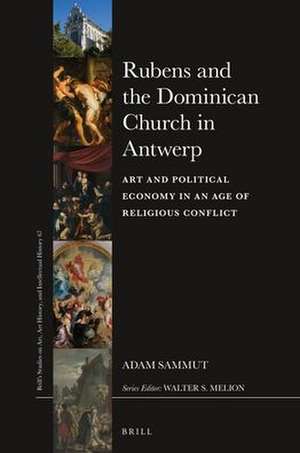Rubens and the Dominican Church in Antwerp: Art and Political Economy in an Age of Religious Conflict: Brill’s Studies on Art, Art History, and Intellectual History, cartea 67
Autor Adam Sammuten Limba Engleză Hardback – 17 mai 2023
Din seria Brill’s Studies on Art, Art History, and Intellectual History
- 18%
 Preț: 864.94 lei
Preț: 864.94 lei - 18%
 Preț: 782.52 lei
Preț: 782.52 lei - 18%
 Preț: 1068.23 lei
Preț: 1068.23 lei - 18%
 Preț: 832.90 lei
Preț: 832.90 lei - 18%
 Preț: 799.10 lei
Preț: 799.10 lei - 18%
 Preț: 798.29 lei
Preț: 798.29 lei - 15%
 Preț: 525.15 lei
Preț: 525.15 lei - 15%
 Preț: 448.27 lei
Preț: 448.27 lei - 18%
 Preț: 704.36 lei
Preț: 704.36 lei - 18%
 Preț: 804.87 lei
Preț: 804.87 lei - 18%
 Preț: 704.36 lei
Preț: 704.36 lei - 18%
 Preț: 753.80 lei
Preț: 753.80 lei - 18%
 Preț: 793.35 lei
Preț: 793.35 lei - 18%
 Preț: 653.92 lei
Preț: 653.92 lei - 18%
 Preț: 753.80 lei
Preț: 753.80 lei - 18%
 Preț: 541.60 lei
Preț: 541.60 lei - 18%
 Preț: 755.79 lei
Preț: 755.79 lei - 18%
 Preț: 654.93 lei
Preț: 654.93 lei
Preț: 1008.48 lei
Preț vechi: 1229.85 lei
-18% Nou
Puncte Express: 1513
Preț estimativ în valută:
192.100€ • 200.75$ • 159.33£
192.100€ • 200.75$ • 159.33£
Carte indisponibilă temporar
Doresc să fiu notificat când acest titlu va fi disponibil:
Se trimite...
Preluare comenzi: 021 569.72.76
Specificații
ISBN-13: 9789004276376
ISBN-10: 9004276378
Pagini: 612
Dimensiuni: 155 x 235 mm
Greutate: 0 kg
Editura: Brill
Colecția Brill
Seria Brill’s Studies on Art, Art History, and Intellectual History
ISBN-10: 9004276378
Pagini: 612
Dimensiuni: 155 x 235 mm
Greutate: 0 kg
Editura: Brill
Colecția Brill
Seria Brill’s Studies on Art, Art History, and Intellectual History
Notă biografică
Adam Sammut, PhD (1990, University of York) is a Leverhulme Early Career Fellow in the Department of History of Art at the University of York. He has published articles on Dutch and Flemish art in Review of Scottish Culture, Dutch Crossing and Nederlands Kunsthistorisch Jaarboek.
Cuprins
Acknowledgements
List of Figures
List of Illustrations
List of Tables
Abbreviations
Introduction
1 Guns and Rosaries: The Ecclesia Laicorum as a Realm of Memory
1 Iconoclasm and the Revolt
2 Places and Realms of Memory
3 The Art of Memory and the Art of Preaching
4 The Enemy Within
5 Conclusion
2 The Mystery Machine: The Cycle as a Proponent of Piety and Peace
1 Antwerp and the Archdukes
2 Joannes Boucquet, ‘A Highly Distinguished Prior’
3 The Rosary Brotherhood
4 Peace and Pictura Sacra
5 Conclusion
3 ‘Outstandingly Great Art yet Not High in Price’: The Rosary Madonna as a Sacred Commodity
1 Made in Rome
2 The Entombment
3 The Death of the Virgin
4 ‘A Very Dear Friend of Caravaggio’s’
5 Conclusion
4 Four Liefhebbers and a Funeral: Procuring The Rosary Madonna for Profit, Fame and Love
1 Love Actualised
2 Friends with Benefits
3 The Gift Economy
4 Two Become One
5 The Art-Lover Formerly Known as Prince
6 The Godly Feast
7 The Art of the Deal
8 Conclusion
5 Apocalypse Later: Michaël Ophovius and the Ecclesia Fratrum
1 The Archaeology of the Choir
2 Unemotional Rescue
3 Back to Basics
4 ‘The Hangman’s Noose for the Bishop’s Mitre’
5 ‘Tears of Blood’
6 Hero-Worship
7 Rubens and ’s-Hertogenbosch
8 Heart of Glass
9 Conclusion
Conclusion
Figures
References 447
Index 515
List of Figures
List of Illustrations
List of Tables
Abbreviations
Introduction
Part I: The Fifteen Mysteries of the Rosary Cycle, 1568–1671
1 Guns and Rosaries: The Ecclesia Laicorum as a Realm of Memory
1 Iconoclasm and the Revolt
2 Places and Realms of Memory
3 The Art of Memory and the Art of Preaching
4 The Enemy Within
5 Conclusion
2 The Mystery Machine: The Cycle as a Proponent of Piety and Peace
1 Antwerp and the Archdukes
2 Joannes Boucquet, ‘A Highly Distinguished Prior’
3 The Rosary Brotherhood
4 Peace and Pictura Sacra
5 Conclusion
Part II: Caravaggio’s Rosary Madonna, c.1603–51
3 ‘Outstandingly Great Art yet Not High in Price’: The Rosary Madonna as a Sacred Commodity
1 Made in Rome
2 The Entombment
3 The Death of the Virgin
4 ‘A Very Dear Friend of Caravaggio’s’
5 Conclusion
4 Four Liefhebbers and a Funeral: Procuring The Rosary Madonna for Profit, Fame and Love
1 Love Actualised
2 Friends with Benefits
3 The Gift Economy
4 Two Become One
5 The Art-Lover Formerly Known as Prince
6 The Godly Feast
7 The Art of the Deal
8 Conclusion
Part III: Rubens’s Wrath of Christ High Altarpiece, 1618–42
5 Apocalypse Later: Michaël Ophovius and the Ecclesia Fratrum
1 The Archaeology of the Choir
2 Unemotional Rescue
3 Back to Basics
4 ‘The Hangman’s Noose for the Bishop’s Mitre’
5 ‘Tears of Blood’
6 Hero-Worship
7 Rubens and ’s-Hertogenbosch
8 Heart of Glass
9 Conclusion
Conclusion
Figures
References 447
Index 515
